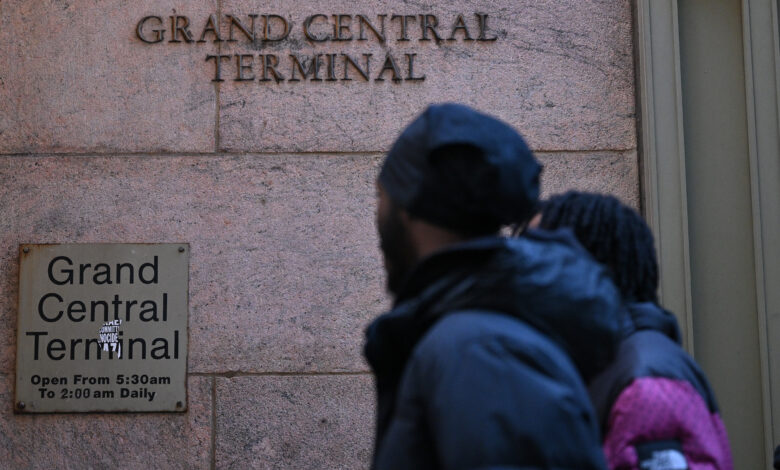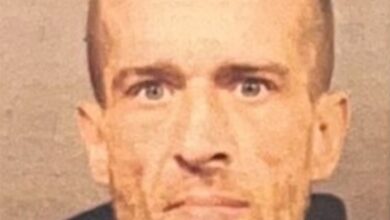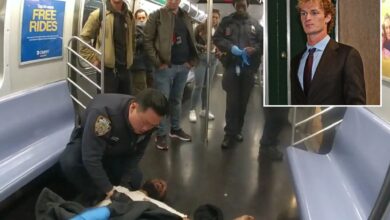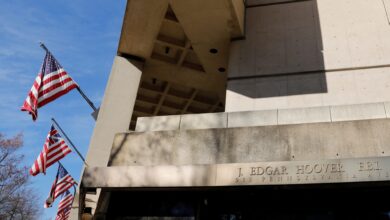A Grand Central stabbing — but Mayor Adams misses the train

As Mayor Adams passes his two-year mark in office this weekend, his response to New York’s latest outrage — the “random” Christmas Day stabbing of two girls at Grand Central Terminal — wasn’t a good augur for the next two years.
This is going to sound, sadly, a bit familiar.
The suspect in the stabbing, Steven Hutcherson, is yet another troubled vagrant.
Before stabbing the two young tourists Christmas morning, allegedly screaming that he would kill white people, he had plagued his fellow New Yorkers for months with threats — threats the city didn’t treat seriously.
He has a long arrest record — at least 17 — and a recent history of mental-health issues.
Police arrested him barely seven weeks ago — for threatening to shoot someone while armed with a knife.
He got off with a discharge, provided he behaved well.
All this year — from a July arrest in which Hutcherson was caught with two blades, to other incidents of “disturbed” behavior — police did their job.
They tried to get Hutcherson off the streets.
All year, New York put him right back on the street.
Adams should be saying: As these arrests prove, his police department can still identify potentially dangerous people and thus prevent crime — if the rest of the system works.
But Adams must tell the public: Why wasn’t Hutcherson, obviously a danger to others, in secure mental-health custody, something Adams largely controls?
And what is Adams’ strategy when it comes to what he doesn’t control?
Like the city’s independently elected district attorneys — Hutcherson’s two earlier, serious arrests this year were in The Bronx — and judges agreeing to plea bargains that release people who are clearly not going to fix themselves?
Does the mayor think the governor’s fixes to the bail laws and the state retraining of judges over the past two years have done enough to stem the city’s four-year-old crime wave?
Adams must tell us: If he is not at fault, then who should we blame? How can we help him hold those parties accountable?
Instead, the mayor missed his opportunity Tuesday to keep the focus on how to fix what’s still broken.
He had planned an end-of-year press conference to talk about how great things are going, and, darn it, he was going to stick to his talking points.
“Crime was moving in the wrong direction,” he said of the two years before he took office. “No one wanted to be on the subway system. . . . But look at us two years later. I say it over and over again, crime is down.”
You can say it as much as you want, Mr. Mayor, but the facts get in the way.
Yes, we’ll likely end 2023 with fewer than 400 murders for the first time in four years.
But the fact we’re remotely pleased with this outcome shows how we’ve lowered our standards.
We had fewer than 400 murders every year between 2013 and 2019.
We’ll likely end 2023, by contrast, with murders still 22% higher than 2019 levels.
Better than where they were in 2021 — 53% above 2019 — but not good enough.
And Adams has made no progress with overall felonies.
With 124,192 felonies as of Christmas Eve, we’ll likely end the year flat, compared with last year — but 21% above 2021, the year before Adams took office, and up 30% since 2019.
Violent assaults, like the Christmas Grand Central Terminal attack?
Through Christmas Eve, at 27,299, felony assaults are up 6% from last year — and we’ll end 2023 a third higher than 2019.
Also Christmas week, a man was stabbed in an apparent robbery in a Times Square subway.
So when a reporter asked him about the Grand Central attack, because he must run away from these numbers, Adams deflected and detoured.
He preferred to talk about migrants: “We’re going to start to see the physical aspects” of the migrant crisis, he said, mysteriously. “An idle mind is the devil’s workshop.”
He seemed to be trying to say that he can’t cut crime as much as he would like because “we had to postpone the police class” and cut other services.
Except: New Yorkers haven’t even seen the on-the-ground result of postponed police classes yet or, for that matter, any public-service reductions.
“I’m looking forward to further driving down crime,” the mayor said Tuesday. “That’s my No. 1 issue I ran on.”
We remember — and we’ll remember in two years.
Nicole Gelinas is a contributing editor to the Manhattan Institute’s City Journal.




